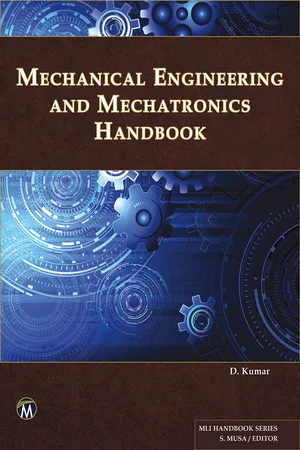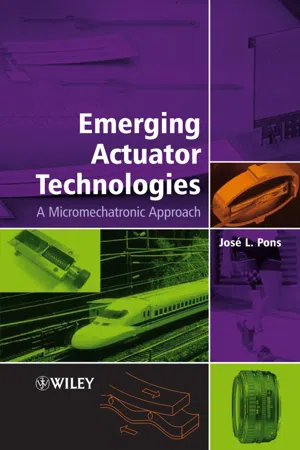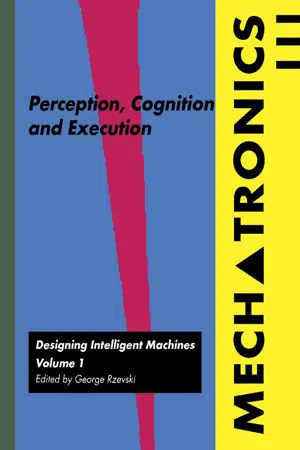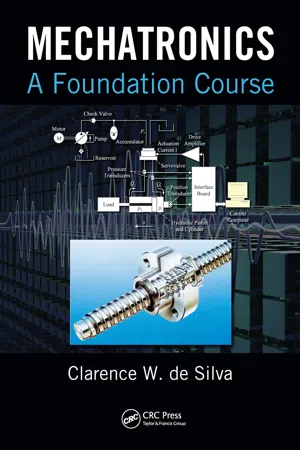Technology & Engineering
Actuator
An actuator is a device that converts energy into motion. It is commonly used in various engineering applications to control or move mechanical systems, such as valves, pumps, and motors. Actuators can be powered by electric, hydraulic, pneumatic, or mechanical means, and they play a crucial role in enabling automated and controlled movements in technology and engineering systems.
Written by Perlego with AI-assistance
6 Key excerpts on "Actuator"
- No longer available |Learn more
- D. Kumar, Sarhan M. Susa(Authors)
- 2022(Publication Date)
- Mercury Learning and Information(Publisher)
10ACTUATION AND ACTUATING SYSTEMS10.1. Actuator AND ACTUATIONAn Actuator is an energy conversion device that makes some things move or operate. Essentially it uses a form of power/energy to convert a control signal into mechanical motion, and the process of energy conversion to mechanical form is called actuation .The Actuators are encountered at house and at workplace. For example:● automatic opening of the door when a person enters a grocery shop, and● forward or backward movement of a car seat.Actuators are located in from electric door locks in automobiles to ailerons in air-crafts. Industrial plants use Actuators to operate valves, dampers, fluid couplings, etc.Actuators are classified by the type of motion and the power source. Linear Actuators produce pull or push action and the linear motion may be along with one or more of the three axes X–X axis, Y–Y axis, and Z–Z axis.FIGURE 10.1 Types of motionThe rotational motion is the motion of a rigid body along with one or more of the three-axis along the X-X axis, Y-Y axis, and Z-Z axis.Depending upon the power source, Actuators are categorized as:● Electromechanical Actuators: These Actuators use AC, DC, or stepper electric motors to convert electrical energy into mechanical work.● Fluid power Actuators: These Actuators use fluid energy that is transmitted through a fluid under pressure. The fluid used is a liquid (water or oil) in a hydraulic Actuator and compressed air or some inert gas in a pneumatic Actuator.● Active material-based Actuators: - eBook - PDF
Emerging Actuator Technologies
A Micromechatronic Approach
- José L. Pons(Author)
- 2005(Publication Date)
- Wiley(Publisher)
Moreover, in some instances, switch- ing techniques are the only way to effectively drive an Actuator (see Chapter 4). The rationale of using switching techniques is described in more detail in Section 1.4. 1.3.3 Actuation In a motion control system, the actuation function is accomplished by the Actuator. The Actuator is the only unavoidable component of a motion control system. As previously defined, the Actuator establishes a flow of energy between the electrical and the mechanical domains. The function of the Actuator is to impose a state on the plant, ideally without being affected by the load. The plant is driven according to the reference trajectory, by either increasing or decreasing the energy level of the plant. The particular way this energy flow is established is determined by the joint interaction of the plant and the Actuator at the output port. This can be easily illustrated by the simple example of an Actuator driving a mass. The Actuator can impose an effort (force) on the mass. However, the flow (velocity) of the plant will be determined by the inertial characteristics of the mass. Here, the mass (plant) is acting as an admittance (it receives an effort and determines the flow). In most situations, the plant acts as an admittance. According to the prin- ciple of causality (Hogan (1985a)), the action of the motion control system on the plant must be complementary to it, that is, wherever the plant is an admit- tance, the control system behaves as an impedance (accepts a flow and imposes an effort). The Actuator ideally will not be affected by the load. In practice, the load will impose limits on the Actuator’s power delivery. Because of its dependence on the load, the Actuator usually behaves as a low pass filter: that is, in the frequency domain, actuation is only possible up to some cutoff frequency, which is closely related to the device’s mechanical time constant (see Figure 1.6). - eBook - PDF
Mechatronics: Designing Intelligent Machines Volume 1
Perception, Cognition and Execution
- George Rzevski(Author)
- 2014(Publication Date)
- Newnes(Publisher)
The selection of appropriate Actuator technologies to satisfy requirements, often within small tolerances and under severe constraints. 7.2 Actuator functions 7.2.1 The range of Actuators Almost all Actuators produce some kind of movement. Movement is required for devices which travel and provide transportation, or have moving parts such as 195 VOLUME ONE arms and grippers on robots. It may be necessary to provide forces to maintain stability by preventing movement, as for example in a support for building construction (though civil engineering has not yet widely adopted mechatronics). An important class of Actuators comprise end effectors, the manipulation mecha-nisms and tools attached to each 'limb' of a robot to provide its end function. These too may provide movement, as with grippers, or be associated with specialized tasks such as welding. The following list gives examples of familiar mechatronic applications and Actuators. (a) Autonomous vehicles These use electric motors for linear movement and steering mechanisms. (b) Remote guided vehicles These are for use in dangerous or constricted areas (bomb and pipe examination). They are not autonomous but may have mechatronic elements. (c) Lifting and handling equipment These often use hydraulic power to control heavy loads with precision. (d) Cameras and video recorders These use miniature electric motors to move lenses small distances. (e) Automobiles Many mechatronic operations such as steering and suspension control require Actuators, e.g. electric motors and hydraulic pumps. (f) Animated models for entertainment and education Humanoid and animal models use mainly pneumatic Actuators to move limbs, eyes and other components to create realistic effects. Electric motors are likely to be used more in the future. (g) Manufacturing machinery A wide range of electric, hydraulic and pneu-matic Actuators is used to move materials and parts for processing and assembling, often at high speed and with great precision. - eBook - ePub
Mechatronic Systems, Sensors, and Actuators
Fundamentals and Modeling
- Robert H. Bishop(Author)
- 2017(Publication Date)
- CRC Press(Publisher)
If the sensor is used to measure a time-varying input, then dynamic calibration becomes necessary. Use of sinusoidal inputs is the most simple and reliable way of dynamic calibration. However, if generating sinusoidal input becomes impractical (e.g., temperature signals), then a step input can substitute for the sinusoidal signal. The transient behavior of step response should yield sufficient information about the dynamic response of the sensor.17.1.2 ActuatorsActuators are basically the muscle behind a mechatronics system that accepts a control command (mostly in the form of an electrical signal) and produces a change in the physical system by generating force, motion, heat, flow, and so forth. Normally, the Actuators are used in conjunction with the power supply and a coupling mechanism as shown in Figure 17.12. The power unit provides either ac or dc power at the rated voltage and current. The coupling mechanism acts as the interface between the Actuator and the physical system. Typical mechanisms include rack and pinion, gear drive, belt drive, lead screw and nut, piston, and linkages.17.1.2.1 ClassicationActuators can be classified on the basis of the type of energy as listed in Table 17.2 . The table, although not exhaustive, lists all the basic types. They are essentially of electrical, electromechanical, electromagnetic, pneumatic, or hydraulic type. The new generations of Actuators include smart material Actuators, microActuators, and nanoActuators.Actuators can also be classified as binary and continuous on the basis of the number of stable state outputs. A relay with two stable states is a good example of a binary Actuator. Similarly, a stepper motor is a good example of continuous Actuator. When used for a position control, the stepper motor can provide stable outputs with very small incremental motion.FIGURE 17.12 A typical actuating unit.TABLE 17.2 Types of Actuators and Their FeaturesFIGURE 17.13 n-Channel power MOSFET.17.1.2.2 Principle of OperationElectrical Actuators: Electrical switches are the choice of Actuators for most of the on–off type control action. Switching devices such as diodes, transistors, triacs, MOSFET, and relays accept a low energy level command signal from the controller and switch on or off electrical devices such as motors, valves, and heating elements. For example, a MOSFET switch is shown in Figure 17.13. The gate terminal receives the low energy control signal from the controller that makes or breaks the connection between the power supply and the Actuator load. When switches are used, the designer must make sure that switch bounce - eBook - PDF
Mechatronics
A Foundation Course
- Clarence W. de Silva(Author)
- 2010(Publication Date)
- CRC Press(Publisher)
465 7 Actuators Study Objectives The purpose of Actuators in a mechatronic system • Types of Actuators • Stepper motors and dc motors (including brushless dc motors) • AC motors (induction motors and synchronous motors) • Linear Actuators • Hydraulic and pneumatic Actuators • Modeling and analysis of Actuators • Practical performance and parameters of Actuators • Sizing and selection of Actuators for practical applications • Instrumentation, drive hardware, and control of Actuators • 7.1 Introduction This chapter introduces the subject of Actuators, as related to mechatronics. The actua-tor is the device that mechanically drives a mechatronic system. Joint motors in a robotic manipulator are good examples of such Actuators. Actuators may be used as well to oper-ate controller components (final control elements), such as servovalves, as well. Actuators in this category are termed control Actuators . Actuators that automatically use response error signals from a process in feedback to correct the operation of the process (i.e., to drive the process to achieve a desired response) are termed servoActuators . In particular, the motors that use measurements of position, speed, and perhaps load torque and armature current or field current in feedback to drive a load to realize a specified motion are termed servomotors . One broad classification separates Actuators into two types: incremental-drive Actuators and continuous-drive Actuators. Stepper motors, which are driven in fixed angular steps, represent the class of incremental-drive Actuators. They can be considered to be digital Actuators, which are pulse-driven devices. Each pulse received at the driver of a digital Actuator causes the Actuator to move by a predetermined, fixed increment of displacement. Continuous-drive devices are very popular in mechatronic applications. Examples are direct current (dc) torque motors, induction motors, hydraulic and pneumatic motors, and piston-cylinder drives (rams). - eBook - PDF
Meso- to Micro- Actuators
A Theoretical and Practical Approach
- Alberto Borboni(Author)
- 2008(Publication Date)
- CRC Press(Publisher)
A is within field B , so the available Actuator can be used for our needs. 140 Meso- to Micro-Actuators: A Theoretical and Practical Approach behavior. For these reasons, some specialized optimization algorithms can be applied via a custom software program to achieve an optimal selection. These selection techniques should take into account many other properties of the considered Actuators; one of the most interesting characteristics is the linearity, that refers to the input–output function of the Actuator, where the input is a physical property of the input energy (current, tension, tempera-ture, etc.) and the output is a physical property of the mechanical output energy (position, speed, acceleration, power, etc.). The maximum difference between a reference linear line and the Actuator output is a measure of the linearity (Figure 2.10); in fact, a high linearity is synonymous with a simple relationship between input and output and it implies facility of commanding the Actuator. An Actuator is used to generate a motion, that can differ, in general, from the commanded motion according to the positioning precision, or, specifi-cally, to the accuracy, the repeatability, and the resolution (Figure 2.11). Accu-racy is the distance between the average attained position and the target position; repeatability is the average distance between the different attained positions and the same target position, whereas resolution is the minimum incremental motion of the Actuator. O I f r l FIGURE 2.10 Definition of linearity: O is the Actuator output, I is the Actuator input, r is the reference line, f is the input–output function, and l is a measure of the linearity. y x T Ar rp ac rs FIGURE 2.11 Definition of planar positioning precision: x and y are two spatial coordinates, T is the target position, a is a measure of the accuracy, Ar is the average reached position, rs is a measure of the resolution, and rp is a measure of the repeatability.
Index pages curate the most relevant extracts from our library of academic textbooks. They’ve been created using an in-house natural language model (NLM), each adding context and meaning to key research topics.





